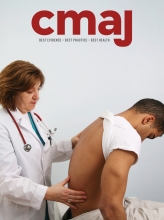Not so long ago, the traditional wisdom in medicine was that there is nothing you can do for a stroke.
“Neurologists, when they were called about a stroke patient would say, ‘Make them comfortable, I’ll see them in the morning,’” Dr. Antoine Hakim, recipient of the 2017 Gairdner Wightman Award explains.
As it turns out, however, there was plenty that could be done. And those discoveries and subsequent progress owes much to researchers like Hakim, says Dr. David Park, director of the University of Ottawa’s Brain and Mind Research Institute.
“He was a thought leader in trying to ensure that wasn’t necessarily the case,” says Park who was recruited by Hakim to work at the institute in the 1990s. Park is the institute’s second director, following Hakim.
Earlier this year, Hakim received the Gairdner Wightman Award for “outstanding research into stroke and its consequences, and championing stroke prevention and treatment in Canada and beyond.” He spoke about his career Oct. 26 in Toronto at the 2017 Gairdner Laureate Symposium.
A key part of Hakim’s leadership, according to Dr. Patrice Lindsay, was his work on the now defunct Canadian Stroke Network, which connected neurologists, politicians and frontline workers in centres of excellence that created a consistent approach to stroke across the country. He then helped develop and apply the nation-wide Canadian Stroke Strategy, aimed at demonstrating how stroke is preventable, treatable and repairable.

In addition to conducting research, Dr. Antoine Hakim streamlined operations so that patients with stroke are treated quickly.
Image courtesy of Courtesy of Antoine Hakim
In 2006, Hakim and colleagues published the first best practice recommendations for stroke care.
“We’ve seen a dramatic drop in stroke mortality, which is fantastic,” says Lindsay.
Hakim’s interest in stroke had a long gestation. Before he even considered being a doctor, he was covered head to toe in tar, working as a chemical engineer in the Alberta tar sands. It wasn’t exactly what he’d had in mind. “I think I’m more of a people person,” Hakim says. He left to pursue a master’s degree in biomedical engineering where a professor urged him to apply to medical school.
As a medical student, Hakim says he was struck by the devastation stroke could bring to both patient and family. An individual would suddenly lose their ability to walk, talk and even understand speech.
His career veered toward research. His paper on the ischemic penumbra published in 1987 changed the way tPA (tissue plasminogen activator), a powerful blood thinner that can bust the clot caused by a stroke, is administered. For example, in a stroke characterized by a weakness in the face, arms and legs, the weakness in the arms may come from a part of the brain that is dead, while the part of the brain affecting the face and legs may simply be “holding its breath,” says Hakim.
“The trick about tPA was, that it was only effective for a short period of time,” he says. “That piece of the brain that was holding its breath because it was deprived of its blood supply couldn’t hold its breath for days and days; it held its breath for about four hours, five hours.”
But government rules and health care processes meant those integral five hours could quickly slip away. Ambulance drivers weren’t allowed to cross municipal boundaries to take patients to the nearest hospital, for example, and paramedics weren’t taught how to respond to a stroke. At that time, neurology, Hakim says, was not considered an emergency speciality.
“In the past, the treatments were available, but they were not properly used efficiently and effectively,” Park says. “In the emergency room, physicians and ‘strokeologists’ were very, very hesitant to use tPA.”
The idea of creating a streamlined system to make the best use of treatments would shape Hakim’s career. He fostered multidisciplinary collaboration so that essential players would work together to treat stroke care as it should be: urgently.
“Now you have neurologists who need to be on call. It’s an emergency,” says Park. And patients suffering a stroke are taken to hospital quickly, which is “quite remarkable.”
Hakim’s work eventually had a global influence. “The World Stroke Organization approved only one best practice guideline in the world and that was the Canadian best practice guideline,” Hakim says. “We can punch above our weight very significantly.”
Hakim, who is 74, gave up his seat on the World Stroke Organization a few years ago, passing it on to Lindsay.
“You can’t ever take Tony’s place,” Lindsay says. “He put Canada on the map.”
Hakim continues to work. In April, he published Save Your Mind: Seven Rules to Avoid Dementia and he is conducting neuroscience research at the University of Ottawa into how the effects of stroke can lead to dementia. He compares bolstering a cognitive reserve to saving funds in a bank account.
“Build up so when you are older, you can spend,” Hakim says.
Footnotes
Posted on cmajnews.com on Oct. 25, 2017.








